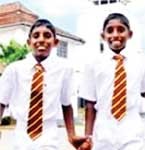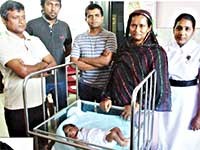Sri Lanka detects its first monkeypox case
Sri Lanka has detected its first case of monkeypox in a person who arrived from Dubai, United Arab Emirates (UAE), the Ministry of Health says.
The 20-year-old Sri Lankan had returned to the island on November 01.
According to reports, the youth in question was referred to the national sexually transmitted disease (STD) clinic on November 02, with fever and skin blisters.
He had been having enlarged lymph nodes and was feeling exhausted. As it was suspected that he is infected with monkeypox, several samples were collected and sent to the Medical Research Institute (MRI.
Accordingly, the Department of Virology of the MRI had performed a monkeypox-specific real-time PCR test overnight.
Specific target genes were detected in every sample. Upon careful analysis, it was confirmed on November 03 that the patient is infected with the monkeypox virus.
MRI has tested six suspected patients for monkeypox since the establishment of real-time PCR assay in July this year. However, this is the first laboratory-confirmed case of monkeypox in Sri Lanka and the seventh suspected case tested by the MRI.
වඳුරු උණට ප්රතිකාර කෙරෙන්නේ මෙහෙමයි
වඳුරු උණ රෝගය මිනිසාගේ ප්රතිශක්තීකරණ පද්ධතිය තුළින්ම පාලනය කරගැනීමට හැකි තත්ත්වයක් පවතින බව වසංගත රෝග විද්යා ඒකකයේ අධ්යක්ෂ විශේෂඥ වෛද්ය සමිත ගිනිගේ මහතා පවසයි.
මාධ්ය වෙත අදහස් දක්වමින් ඒ මහතා වැඩිදුරටත් ප්රකාශ කර සිටියේ මේ සඳහා නිශ්චිත ප්රතිකාරයක් වෙනුවට රෝග ලක්ෂණවලට ප්රතිකාර දීම සිදුකෙරෙන බවය.
එහිදී වැඩිදුරටත් අදහස් දැක්වූ වසංගත රෝග විද්යා ඒකකයේ අධ්යක්ෂ විශේෂඥ වෛද්ය සමිත ගිනිගේ මහතා,
“මේක හැදුනාම ශරීරයේ ප්රතිශක්තීකරණ පද්ධතිය තුළින්ම මේක පාලනය කරගන්න පුළුවන් තත්ත්වයක් තියෙනවා. ඊට අමතරව බොහෝවිට නිශ්චිත ප්රතිකාරයකට වඩා තියෙන්නේ. රෝගියාට ඇතිවන රෝග ලක්ෂණවලට ප්රතිකාර කිරීමක් තමයි සිද්ධවෙන්නේ. බොහොම වගකීමකින් කියන්නට පුළුවන් මේ පුද්ගලයා හරහා අපේ ප්රජාවට බෝවීමේ කිසිම ඉඩකඩක් දැනට තියෙන තත්ත්වය අනුව කිසිම අවකාශයක් නෑ.”
ශ්රී ලංකාවෙන් පළමුවරට වඳුරු උණ ආසාදිතයෙකු හඳුනාගත් බව සෞඛ්ය අමාත්යාංශය අද තහවුරු කළේය.
ඒ ඩුබායි සිට මෙරටට පැමිණි 19 හැවිරිදි තරුණයෙකුය.
මේ තරුණයා දිවයිනට පැමිණ තිබුණේ ඉකුත් නොවැම්බර් 01 වනදාය.
රෝග ලක්ෂණ කිහිපයක් මතුවීම නිසා ඔහු වෛද්ය සායනයකට යොමු වී තිබුණි.
එහිදී ඔහු ගැන සැක පළකළ වෛද්යවරු, ඔහුගේ සමෙහි තුවාළවලින් ලබාගත් සාම්පල වෛද්ය පර්යේෂණ ආයතනය වෙත නොවැම්බර් 02 වනදා යොමු කර තිබුණි.
කඩිනම් පරීක්ෂණයකින් පසු එම ආයතනය ඔහු මන්කිපොක්ස් ආසාදිතයෙකු බව තහවුරු කර ඇත.
මෙලෙස ශ්රී ලංකාවෙන් මන්කිපොක්ස් ආසාදිතයෙකු වාර්තා වුණේ ලෝක සෞඛ්ය සංවිධානය එය ගෝලීය හදිසි සෞඛ්ය තත්ත්වයක් ලෙස ප්රකාශයට පත් කර මාස 03කට පමණ පසුවය.
මේ වසරේ රටවල් 109කින් මන්කිපොක්ස් ආසාදිතයින් 73,000කට වැඩියෙන් හඳුනාගෙන ඇති අතර ලෝක සෞඛ්ය සංවිධානය තහවුරු කර ඇති මරණ ගණන 29කි.
ඩුබායි සිට මෙරටට පැමිණි 19 හැවිරිදි තරුණයා මන්කිපොක්ස් ආසාදිත බවට හඳුනාගැනීමෙන් පසු ප්රතිකාර ලබාදීම සඳහා ජාතික බෝවන රෝග විද්යායතනය වෙත යොමු කර තිබේ.
ආසාදිතයාගේ ආශ්රිතයින් මේ වනවිට නිරෝධායනයට ලක් කර ඇති බව සෞඛ්ය සේවා අධ්යක්ෂ ජනරාල් වෛද්ය අසේල ගුණවර්ධන මහතා සඳහන් කළේය.
මන්කිපොක්ස් රෝගයේ මූලික ලක්ෂණ ලෙස තද උණ, ලිංගික අවයවවල සහ ශරීරය පුරා පැතිර යන බිබිලි සමග වසාගැටිති ඉදිමුම හඳුනාගත හැකිය.
මන්කිපොක්ස් හෙවත් වඳුරු උණ වෛරසය පළමු වරට හඳුනාගැනෙන්නේ 1958 වසරේ ඩෙන්මාර්කයේ කෝපන්හේගන්හි රසායනාගාර පරීක්ෂණ සඳහා යොදා ගැනුණු වඳුරු විශේෂ අතරිනි.
පසුව 1970 වසරේදී පළමුවරට මිනිසුන්ට ද එම වෛරසය වැළඳෙන බවට තහවුරු වෙමින් කොංගෝ ජනරජයෙන් ආසාදිතයින් වාර්තා වී තිබුණි.
කෙසේවෙතත් ඒ වනවිට ලොවපුරා ක්රියාත්මක කළ වසූරිය මර්දන එන්නත්කරණ වැඩසටහන යටතේ මන්කිපොක්ස්වලට එරෙහිව ද ප්රතිශක්තිය ලැබීම හේතුවෙන් වෛරසයේ ගෝලීය පැතිරීමක් වාර්තා වී නොතිබුණි.
සාමාන්යයෙන් මන්කිපොක්ස් වෛරසය මධ්යම හා බටහිර අප්රිකානු කලාපයේ රාජ්යයවලට පමණක් සීමා වී තිබූ වසංගතයකි.
නමුත් එම තත්ත්වය උඩු යටිකුරු කරමින් මේ වසරේ එක්සත් රාජධානියෙන් ආසාදිතයෙකු වාර්තා වන්නේ පසුගිය මැයි මස 06 වනදායි.
ඉන්පසු මන්කිපොක්ස් පැතිරීමේ කේන්ද්රස්ථානය බවට යුරෝපය පත්කරමින් ජර්මනිය,නෙදර්ලන්තය,නෝර්වේ, ස්පාඤ්ඤය ඇතුළු රටවලින් ආසාදිතයින් වාර්තා වීම ඉහළ ගියේය.
ඉකුත් ජුලි මාසයේදී ඉන්දියාවෙන්ද මන්කිපොක්ස් ආසාදිතයින් සිව්දෙනෙකු සහ එක් පුද්ගල මරණයක් වාර්තා වුණි.
නමුත් දකුණු ආසියාතික රටවලින් සමස්තයක් ලෙස වාර්තා වී ඇති රෝගීන් ගණන 23කි.
What is monkeypox?
Monkeypox is an illness caused by the monkeypox virus. It is a viral zoonotic infection, meaning that it can spread from animals to humans. It can also spread from humans to other humans and from the environment to humans.
What are the symptoms of monkeypox?
Monkeypox can cause a range of signs and symptoms. While some people have less severe symptoms, others may develop more serious illness and need care in a health facility. Those typically at higher risk include people who are pregnant, children and persons that are immunocompromised.
The most common symptoms of monkeypox identified during the 2022 outbreak include fever, headache, muscle aches, back pain, low energy and swollen lymph nodes, followed or accompanied by the development of a rash which may last for two to three weeks. The rash can affect the face, palms of the hands, soles of the feet, groin, genital and/or anal regions. It may also be found in the mouth, throat, anus or vagina, or on the eyes. The number of sores can range from one to several thousand. Sores on the skin begin flat, then fill with liquid before they crust over, dry up and fall off, with a fresh layer of skin forming underneath.
There are ongoing studies to keep track of and better understand symptoms during this new outbreak, including what parts of the body can be affected and how long symptoms may last.
Anyone who has symptoms that could be monkeypox or who has been in contact with someone who has monkeypox should call or visit a health care provider and seek their advice.
Symptoms usually go away on their own or with supportive care, such as medication for pain or fever. People remain infectious until all of the sores have crusted over, the scabs have fallen off and a new layer of skin has formed underneath.
Can people get seriously ill or die from monkeypox?
In most cases, the symptoms of monkeypox go away on their own within a few weeks. However, in some people, an infection can lead to medical complications and even death. Based on what we know from previous monkeypox outbreaks, new-born babies, children and people with underlying immune deficiencies may be at higher risk of more serious symptoms and death from monkeypox.
Complications from monkeypox include secondary skin infections, pneumonia, confusion, and eye problems. More recent complications include proctitis (sores and swelling inside the rectum that cause pain) and pain or difficulty when urinating. In the past, between 1% to 10% of people with monkeypox have died. It is important to note that death rates in different settings may differ due to a number of factors, such as access to health care. These figures may be an overestimate because surveillance for monkeypox has generally been limited in the past.
In the newly affected countries where the current outbreak is taking place, some deaths have been reported. This underscores the fact that monkeypox is a serious disease and that people should continue to do everything they can to protect themselves and others
How does monkeypox spread from person to person?
Monkeypox spreads from person-to-person through close contact with someone who has a monkeypox rash. Close contact can mean being face-to-face (such as talking, breathing or singing close to one another which can generate droplets or short-range aerosols); skin-to-skin (such as touching or vaginal/anal sex); mouth-to-mouth (such as kissing); or mouth-to-skin contact (such as oral sex or kissing the skin). Possible mechanisms of transmission through the air for monkeypox are not yet well understood and studies are underway to learn more.
We are still learning about how long people with monkeypox are infectious for, but generally they are considered infectious until all of their sores have crusted over, the scabs have fallen off and a new layer of skin has formed underneath, and all the sores on the eyes and in the body (in the mouth, throat, eyes, vagina and anus) have healed too.
Environments can become contaminated with the monkeypox virus: for example, when an infectious person touches clothing, bedding, towels, objects, electronics and surfaces. Someone else who touches these items may become infected if they have any cuts or abrasions or they accidentally touch their eyes, nose mouth or other mucous membranes. This is known as fomite transmission. Cleaning your hands after touching objects that may be contaminated can help prevent this type of transmission. It is also possible to become infected from breathing in skin flakes or virus from clothing, bedding or towels. In the current outbreak, experts are still trying to understand whether this mode of transmission plays a major role.
The virus can also spread during pregnancy to the fetus, during or after birth through skin-to-skin contact, or from a parent with monkeypox to an infant or child during close contact.
Although asymptomatic infection has been reported, it is not clear whether people without any symptoms can spread the disease or whether it can spread through other bodily fluids. Live monkeypox virus has been isolated from semen, but it is not yet known whether infection can spread through semen, vaginal fluids, amniotic fluids, breastmilk or blood. Research is underway to find out more about whether people can spread monkeypox through the exchange of these fluids during and after symptomatic infection.




















